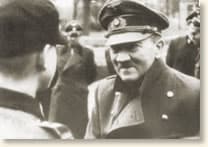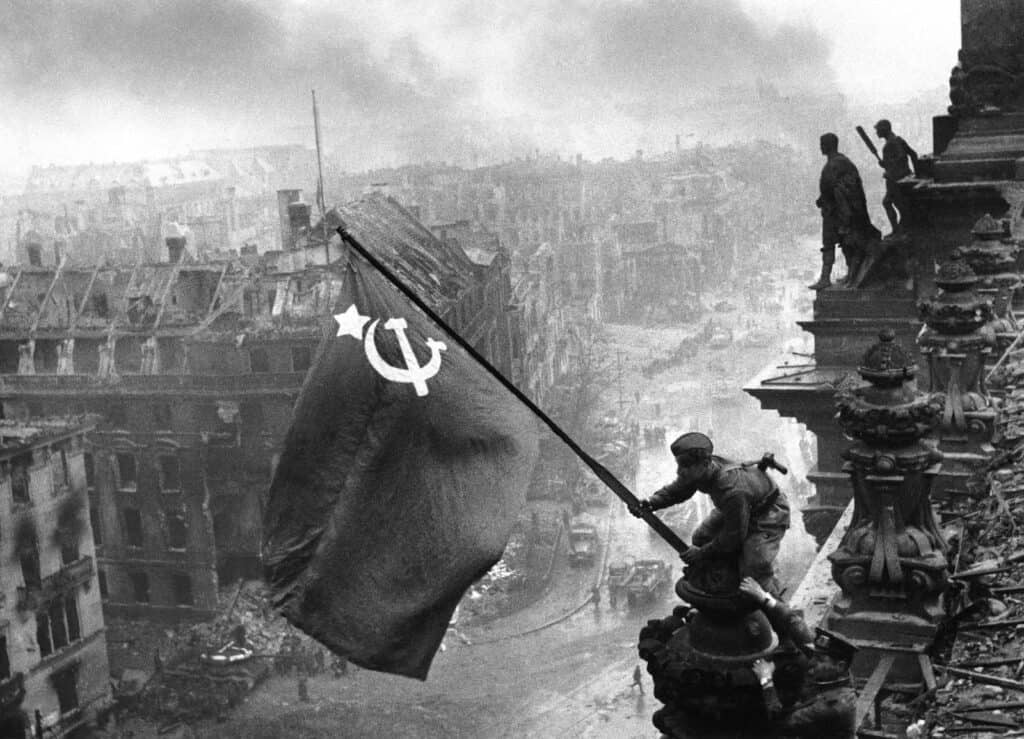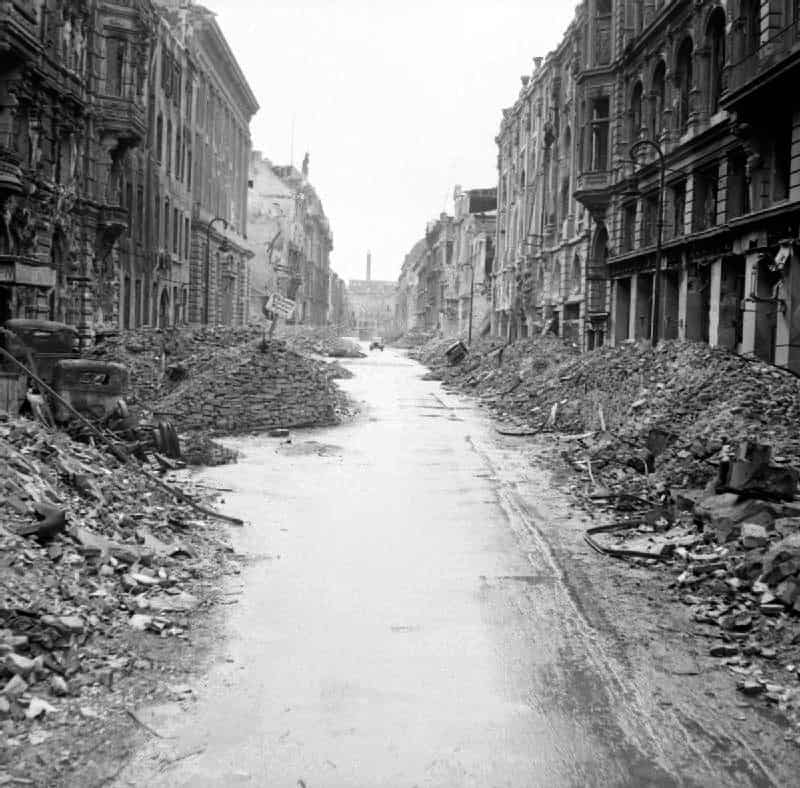See source for featured image.
“If the war is lost, then it is of no concern to me. If people perish in it, I still would not shed a single tear for them, because they do not deserve better.” – Adolf Hitler.
Essential Questions: Why was the final stage of the war in Europe so destructive? Why did the German state collapse to the point that it lost credibility? Why was Hitler under such illusions that he would succeed when everything spoke to the opposite.
Learning Objectives:
In this lesson, students will be able to analyze documents that detail the last days of the Third Reich and the historical figures that experienced the Battle of Berlin.
They will practice close reading as they thoroughly examine documents that reveal historical connections among significant events that reflect the context of the era in question and why events transpired as they did.
By the end of the lesson, they will have an understanding of why the last days of the war were as destructive as they were and how it led to a societal collapse that destroyed the Nazi regime.
Background information: The Third Reich had been engaged in a 6 year long conflict by the time that 1945 rolled around. The propaganda fed to the Germans during this time was very effective to say the least and it bolstered an intense form of nationalism that would prove self destructive as it reflected a reality that didn’t exist. The United States was liberating Western Europe from the control of the Nazis, France was free and the most recently fought Battle of the Bulge was a military failure.
However, as detrimental as these changes were, a far larger threat was threatening to envelop the collapsing German war machine: The Soviet Union. The eastern campaigns failed to take Moscow, Stalingrad or the precious oil fields that the Soviets held to the envy of the Nazis. Over the next few years, the red army would push back the German theater closer and closer to the Rhineland, as the Polish resistance among others joined the Russians in conquering former German territory.
The German generals knew the war was lost by the end of 1942 but no assassination attempt would remove Hitler from power. Fervent nationalism and a belief in a glorious destiny prevented Hitler and his supporters from surrendering peacefully. Hitler’s belief in a final victory that would turn things around, though contagious to the point that child soldiers would die opposing the Red Army, was rooted in fantasy and failed to reflect the war he started. The Germans were indoctrinated and ordered to fight to the end as there was no future for them if they lost; a loss against the Russians would mean the death of society. This is the setting of 1945. This is where the Third Reich would meet its end.
Document 1: Eyewitness Account of a German Civilian, Dorothea von Schwanenfluegel April 20th, 1945

“Friday, April 20, was Hitler’s fifty-sixth birthday, and the Soviets sent him a birthday present in the form of an artillery barrage right into the heart of the city, while the Western Allies joined in with a massive air raid.
The radio announced that Hitler had come out of his safe bomb-proof bunker to talk with the fourteen- to sixteen-year-old boys who had ‘volunteered’ for the ‘honor’ to be accepted into the SS and to die for their Fuhrer in the defense of Berlin. What a cruel lie! These boys did not volunteer, but had no choice, because boys who were found hiding were hanged as traitors by the SS as a warning that, ‘he who was not brave enough to fight had to die.’ When trees were not available, people were strung up on lamp posts. They were hanging everywhere, military and civilian, men and women, ordinary citizens who had been executed by a small group of fanatics. It appeared that the Nazis did not want the people to survive because a lost war, by their rationale, was obviously the fault of all of us. We had not sacrificed enough and therefore, we had forfeited our right to live, as only the government was without guilt. The Volkssturm was called up again, and this time, all boys age thirteen and up, had to report as our army was reduced now to little more than children filling the ranks as soldiers.
In honor of Hitler’s birthday, we received an eight-day ration allowance, plus one tiny can of vegetables, a few ounces of sugar and a half-ounce of real coffee. No one could afford to miss rations of this type and we stood in long lines at the grocery store patiently waiting to receive them. While standing there, we noticed a sad looking young boy across the street standing behind some bushes in a self-dug shallow trench. I went over to him and found a mere child in a uniform many sizes too large for him, with an anti-tank grenade lying beside him. Tears were running down his face, and he was obviously very frightened of everyone. I very softly asked him what he was doing there. He lost his distrust and told me that he had been ordered to lie in wait here, and when a Soviet tank approached, he was to run under it and explode the grenade. I asked how that would work, but he didn’t know. In fact, this frail child didn’t even look capable of carrying such a grenade. It looked to me like a useless suicide assignment because the Soviets would shoot him on sight before he ever reached the tank.
By now, he was sobbing and muttering something, probably calling for his mother in despair, and there was nothing that I could do to help him. He was a picture of distress, created by our inhuman government. If I encouraged him to run away, he would be caught and hung by the SS, and if I gave him refuge in my home, everyone in the house would be shot by the SS. So, all we could do was to give him something to eat and drink from our rations. When I looked for him early next morning he was gone and so was the grenade. Hopefully, his mother found him and would keep him in hiding during these last days of a lost war.”
1.) What can be inferred about socio-economic conditions within Germany during 1945?
2.) Does this source seem credible? Is it valid for study? Why or why not?
3.) What does this document reveal about the way that the government was being run during this time? Why might the Nazi’s have turned to child soldiers?
Document 2: Goring’s Telegram (Translated), April 23rd, 1945

“My Fuhrer: General Koller today gave me a briefing on the basis of communications given to him by Colonel General Jodl and General Christian, according to which you had referred certain decisions to me and emphasized that I, in case negotiations would become necessary, would be in an easier position than you in Berlin. These views were so surprising and serious to me that I felt obligated to assume, in case by 2200 o’clock no answer is forthcoming, that you have lost your freedom of action. I shall then view the conditions of your decree as fulfilled and take action for the well-being of Nation and Fatherland. You know what I feel for you in these most difficult hours of my life and I cannot express this in words. God protect you and allow you despite everything to come here as soon as possible. Your faithful Hermann Goring”.
1.) What does this reveal about the German command structure?
2.) Is there anything of note within the document itself? Anything in regard to the diction and phrasing?
3.) How might Hitler and others within the German state have reacted to this telegram? Why?
Document 3: Traudl Junge’s Account, an excerpt from the personal novel, To The Last Hour: Hitler’s Last Secretary
“Only when Eva Braun comes over to me is the spell broken a little. She smiles and embraces me. “Please do try to get out. You may yet make your way through. And give Bavaria my love,” she says, smiling but with a sob in her voice. She is wearing the Führer’s favourite dress, the black one with the roses at the neckline, and her hair is washed and beautifully done. Like that, she follows the Führer into his room – and to her death. The heavy iron door closes.
I am suddenly seized by a wild urge to get as far away from here as possible. I almost race up the stairs leading to the upper part of the bunker. But the Goebbels children are sitting halfway up, looking lost. They felt they’d been forgotten in their room. No one gave them any lunch today. Now they want to go and find their parents, and Auntie Eva and Uncle Hitler. I lead them to the round table. “Come along, children, I’ll get you something to eat. The grown-ups have so much to do today that they don’t have any spare time for you,” I say as lightly and calmly as I can. I find ajar of cherries, butter some bread and feed the little ones. I talk to them to distract them. They say something about being safe in the bunker, and how it’s almost fun to hear the explosions when they know the bangs can’t hurt them. Suddenly there is the sound of a shot, so loud, so close that we all fall silent. It echoes on through all the rooms. “That was a direct hit,” cried Helmut, with no idea how right he is. The Führer is dead now.”
1.) How well can be trust this firsthand account? Are there any biases that could be at play?
2.) What could you infer about conditions within the Fuhrerbunker? What would the atmosphere have been for those within?
3.) What would attitude towards Hitler be at this time? What connection would Traudl have? Explain using the text above.
Document 4: Eric Schneyder’s journalist record of the Fall of Berlin. May 2 and 3, 1945.
Excerpt below.
“The Russians have arrived. Sharp commands in a foreign language which reach the ears of those in the shelter leave no doubt about that. The three friends have found refuge somewhat away from the rest of the inmates of the shelter. They hear one after another disappear and know that the Russians have taken them prisoner. E.S. offers to reconnoiter. As he gropes his way, he smells the odor of Russian boots. Outside two Russian guards are posted. As they see him emerge, they point their guns at him and call out, “Stoi!” So that is his first encounter with the enemy, he reflects. One of them raises his, E.S.’s hands, while the other searches him for weapons. He is then kicked into the street. The street is under cannon fire, so E.S. quickly jumps back into the shelter just as some German police are surrendering and attention is diverted to them. Down below he finds the policemen’s weapons scattered all over the place, and in the janitor’s air raid quarters a lot of civilians, men, women, and children, huddled together in a community of despair.”
“Suddenly the door is torn open and broad-shouldered Russian farmer boys in uniform form order all males to come out. The cries of women and children avail nothing; no man is allowed to remain below. As the guards seize E.S., he manages somehow to persuade one of them to go with him to the cubbyhole in which his two friends are awaiting him…. The seventeen-year-old Russian soldier is quite as scared to follow E.S. to his wing of the shelter as E.S. is scared of the Russian, who keeps his gun poked into his back. When they reach the compartment, E.S. calls his two comrades by name and teh Russian is greatly relieved to note that neither have weapons and that there is nobody else in the shelter. He permits the three to take their blankets and a few belongings, and then marches them over to the Esplanade Hotel. There they see all their companions of the night before–“cowboy.” the police, etc. E.S. knows every nook and cranny in this hotel belonging to the Stinnes industrial dynasty, but realizes there is no possibility of escape.”
1.) How does this account compare to that of the first document? Does this seem more or less reliable? Why or why not?
2.) What biases might be playing a role in this transcription? Could anything be exaggerated or downplayed? If so, what?
3.) How would the Russians be perceiving this occupation? How would the Germans perceive the occupation?
Document 5: Soviet Flag over the Reichstag.

1.) What does this picture symbolize? What is the artist trying to convey?
2.) What is revealed by the background? What might be left out if anything?
3.) Does this image reflect the accounts and the destruction described above? Why or why not?
Closing
After the students have had the chance to examine these documents, they will have a chance to share their observations with the instructor and their experience going through these documents. A short discussion would follow as they explain the connections between the sources and why this event was so important in history.


Patrick, A very powerful lesson. Kudos on finding such a fascination collection of sources. (Most are new to me.)
The lesson opens with some well-crafted essential questions – the learning objective and background information clearly set the stage for students to examine the source material.
The source documents are clearly presented and the scaffolding question are well-designed to keep students focused on the material and the task. The scaffolding questions consistently get at the essential skills of sourcing, contextualizing and corroboration.
Overall the lesson “pulls back the curtain” on the closing hours of the Third Reich in a thoughtful and scholarly way. (As opposed to lurid speculation of what happened to Hitler’s body?)
You should take pride in this lesson. It speaks to your mastery of the skills taught in this course.